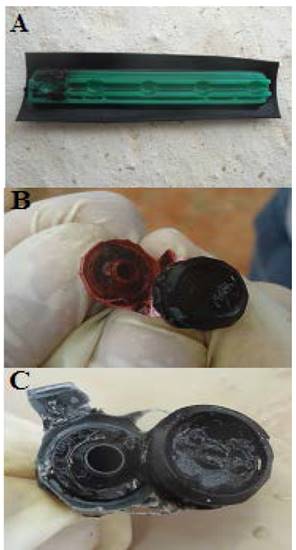1. Introduction
Cashew culture, with a cultivated area of 740,000 ha and a yearly production of approximately 250 tons of nuts and 2 million tons of stalk, employs some 280,000 people in Brazil. Further, 94% of Brazilian production comes from the Northeastern region, whose largest plantations lie along the coast and within the transition region between the states of Ceará, Piauí and Rio Grande do Norte [1].
Since the cashew nut undergoes several steps within the manufacturing process, large volumes of wastewater are produced. Effluents are generated from washing and humidification processes of nuts and from the cleansing of equipment used in the manufacturing process [2,3]
Drip irrigation systems are recommended for wastewaters due to their high efficiency and low contamination risk of the agricultural product and operators on the field [4]. However, drip irrigation systems feature emitters with significant clogging susceptibility [5,6].
The formation of biofilms on drip emitters and on the side lines of drip irrigation systems has become a major issue to farmers and researchers working with the application of wastewater for irrigation [7,8].
The clogging of drip emitters changes the operating pressure rates, flow rate and application uniformity of the drip irrigation system. Agricultural production is consequently impaired [9].
The effects of elevated operating pressure in the hydraulic network of a drip irrigation system with clogged emitters are significant [10]. Results reveal that reduction in flow rate of drip emitters significantly increases at the water distribution pipeline pressure, particularly at 50% clogging.
Pressure increase becomes a low-cost, easy-operation and high-efficiency alternative to prevent biofilm formation and to minimize the clogging of drip emitters. Changes in the operating pressure rates affect the clogging process of drip emitters due to change in the flow regime, resulting in impacts on sediment deposition and biofilm formation [11].
Current assay analyzes the effect of different operating pressures on the clogging of emitters and on the Christiansen uniformity coefficient (CUC) in drip irrigation systems operating with wastewater from cashew nut processing.
2. Materials and methods
Current assay was conducted at the Water Reuse Experimental Unit (WREU) at the Zoo-Botanical Park of the Federal Rural University of the Brazilian Semi-Arid Region (UFERSA), Mossoró RN Brazil, at 5º12'27"S and 37º19'21"W.
An experimental setup for all tests, made of masonry, 2.0 m wide and 8.0 m long, and provided with waterproof floor with inclination of 1%, was assembled at WREU. It also comprised a channel with a 2% inclination for effluent recirculation to minimize losses by evaporation. A masonry reservoir with a capacity to store 5.0 m3 was built downstream of the bench.
Four drip irrigation units were assembled within the experimental setup. They were composed of a 1.0 hp pump, a 1.5 m3 h-1 hydrometer, a screen filter with 130 μm openings, 32 mm PVC branch line, and polyethylene side lines with nominal diameter of 16 mm, provided with three emitters (Fig. 1).
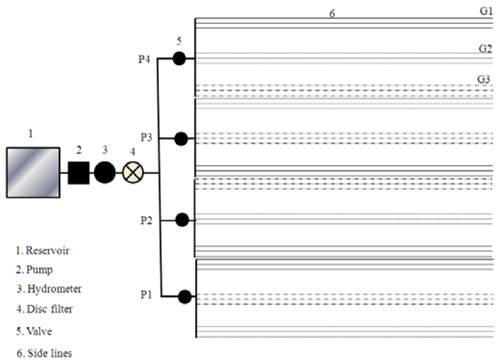
Source: The authors
Figure 1 Experimental setup composed of four drip irrigation units operating at pressures 280 (P4), 210 (P3), 140 (P2) and 70 (P1) kPa and with emitter G3, G2 and G1.
At the beginning of each branch line, gate valves were installed to control operating pressure in drip irrigation units (70, 140, 210 and 280 kPa) and nine connectors were inserted in the branch line of each fertigation unit.
Three side lines with 8 m in length were installed for each drip emitter model. The three emitters were selected due to their low susceptibility to clogging and to their great availability on the Brazilian market (Table 1).
Table 1 Characteristics of drip emitters (G) used in tests: nominal flow rate (Q), self-compensating device (AD), filtration area (A), labyrinth length (L), recommended pressure range (P) and spacing between emitters (EE).

Source: The authors
The drip irrigation units worked, on average, four hours per day, up to 160 h. Flow of drip emitters, effluent application uniformity, volume of effluent applied daily, and physical, chemical and biological characteristics of effluent were determined during the period.
Flow rate was measured in seven emitters from the side lines of drip irrigation units by collecting the volume applied for three minutes. The operating pressure was measured daily with a glycerin pressure gauge, graduated from 0 to 400 kPa.
Performance of drip irrigation units was evaluated every 20 working hours during 160 h of effluent application. The effluent application uniformity was calculated by Eq. 1.
where CUC - Christiansen uniformity coefficient, %; Qi - flow of each drip emitter, L h - 1; Qm - mean drip emitter flow, L h - 1; ne - number of drip emitters.
Wastewater from the processing of cashew nuts used in this study came from the Wastewater Treatment Plant (WWTP) of company AFICEL, Mossoró RN Brazil. The industrial liquid effluent originated from the humidification process of fresh cashew nuts, washing of fresh cashew nuts and floor cleansing.
The physical, chemical and biological characteristics of cashew nuts wastewater were calculated every 20 working hours of drip irrigation units, following recommendations by Standard Methods [12].
In the Laboratory of Soil, Water and Plant Analysis (LSWPA), Department of Environmental and Technological Sciences of UFERSA, pH values were determined by benchtop pH-meter; total iron (Fe) and total manganese (Mn) concentrations were determined by atomic absorption spectrometry; and calcium (Ca2+) and magnesium (Mg2+) concentrations were calculated by titration method. The concentrations of suspended solids (SS) and total solids (TS) were determined by the gravimetric method and the concentrations of dissolved solids (DS) were obtained by the difference between TS and SS.
Population levels of total coliforms (TC) were determined at the Laboratory of Inspection of Animal Products, Department of Animal Sciences - UFERSA, by the multiple tubes method.
The experiment was arranged in split-split-plot scheme, with pressures as plots (70, 140, 210 and 280 kPa), drip emitter models as split-plots (G1, G2 and G3) and assessment periods as split-split-plots (0, 20, 40, 60, 80, 100, 120, 140 and 160 h), within a completely randomized design, with three replications.
Data were submitted to analysis of variance (ANOVA) with F test at 5% probability. Means were compared by Tukey´s test at 5% probability. Regression models were chosen based on the significance of regression coefficients by applying the "t" test at 10% probability on regression parameters and the process under study.
3. Results and discussion
Table 2 shows the means and standard deviation of physicochemical and microbiological characteristics of wastewater from cashew nut processing.
Table 2 Mean and standard deviation of physical, chemical and microbiological characteristics of wastewater from the processing of cashew nuts.

Source: The authors
Table 2 shows that pH, suspended solids (SS) and dissolved solids (DS) provide severe clogging risk of drip emitters, according to guidelines presented by [13]. [14] reported that clogging risk of drip emitters was rated severe for pH and SS in the case of tertiary domestic sewage, whilst clogging risk of drip emitters was rated low for DS. In the case of wastewater from the pulping of coffee fruits, [15] and [5] revealed that clogging risks of drip emitters were classified as low, moderate and severe, for pH, SS and DS.
Total manganese (Mn) and total iron (Fe) showed moderate risk of clogging of drip emitters, already established by [13]. The average content of Fe was less than 1.7 mg L-1 obtained by [14], for tertiary domestic sewage, which also represented moderate risk of clogging of drip emitters. Further, [14] demonstrated that Mn was not observed in tertiary domestic sewage and the risk of clogging of drip emitters was rated low.
Calcium (Ca2+) and magnesium (Mg2+) concentrations in the wastewater of this research showed moderate and low clogging risk of drip emitters, respectively, according to [16].
Working with domestic sewage treated through activated sludge system, [6] ranked low and moderate the clogging risk of drip emitters caused by Ca2+ and Mg2+, respectively, whilst [14], working with tertiary domestic sewage, showed that Ca2+ and Mg2+ proved to have low clogging risk of drip emitters.
The population level of total coliforms (TC) represented low risk of clogging of drip emitters, following [13]. This result was similar to that forwarded by [6] in which the risk of clogging due to TC was also low.
Fig. 2 shows the Christiansen uniformity coefficient (CUC) in drip irrigation units with G1, G2 and G3 operating with wastewater from the processing of cashew nuts under different operating pressures.
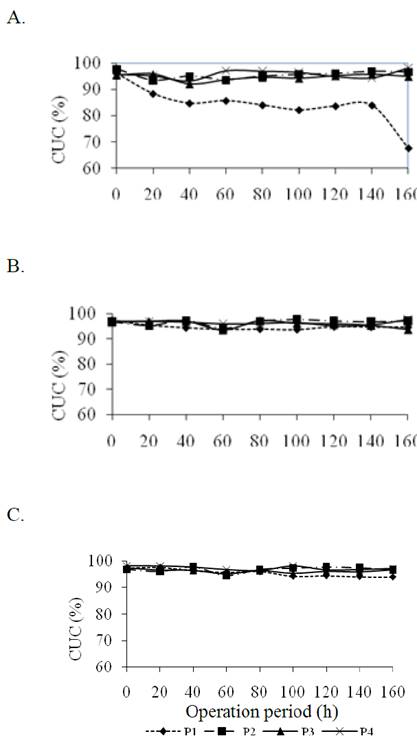
Source: The authors
Figure 2 Mean rates of Christiansen uniformity coefficient (CUC) over the operation period of drip irrigation units with emitters G1 (A), G2 (B) and G3 (C) submitted to operating pressures P1 (70 kPa), P2 (140 kPa), P3 (210 kPa) and P4 (280 kPa).
Drip irrigation units with emitter G1 submitted to operating pressures P1, P2, P3 and P4 at initial operation time and 160 hours showed CUC rates of 96 and 68%; 98 to 97%; 95 and 95% and 96 and 98%, respectively (Fig. 2A). According to [17], CUC rates at operation time 160 hours were rated excellent (> 90%) at operating pressures P2, P3 and P4, while this coefficient was rated poor at operating pressure P1. Irrigation units with emitter G2, submitted to operating pressures P1, P2, P3 and P4 at initial operation time and 160 hours showed CUC rates of 97 and 95%, 97 and 97%, 97 and 94% and 97 and 98%, respectively (Fig. 2B). All CUC rates were rated excellent (>90%) by [17].
At initial operation times and 160 hours, the drip irrigation units with emitter G3 submitted to operating pressures P1, P2, P3 and P4 showed CUC rates of 97 and 94%; 97 and 97%; 98 and 97% and 98 and 97%, respectively (Figure 2C). All CUC values were rated excellent (> 90%) by [17].
When compared to G2 and G3 in operating pressure P1 (70 kPa), a greater clogging susceptibility of emitter G1 was associated with increased labyrinth length and lower flow, conditions in which effluent flow velocity inside the emitter is lower, favoring particle deposition as adhesion of bacteria-forming biofilms. Above results corroborate those by [6-8,14,18].
Table 3 summarizes the analysis of variance (ANOVA) of CUC of drip irrigation units with G1, G2 and G3 under different operating pressures in the split-split-plots scheme. In fact, the interaction between operating pressure (P), drip emitter model (G) and operation time (T) was significant at 1% probability by F test, and according to ANOVA results, the P x G x T interaction was performed.
Table 3 Summary of the analysis of variance for CUC in the split-split-plot scheme.
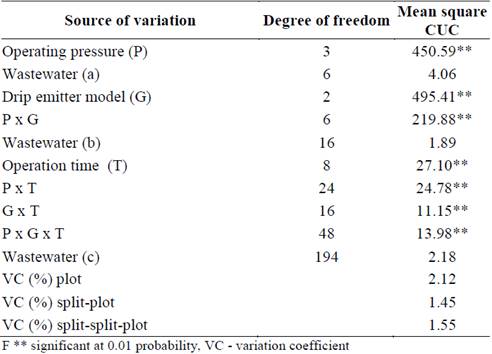
Source: The authors
Table 4 shows regression equations with the best fit to the CUC variable of irrigation units as a function of the operating pressure and operation time for different emitters.
Table 4 Regression equations of CUC variable of irrigation units as a function of the operating pressures and operation times for different drip emitter models studied and their determination coefficients.

Source: The authors
A quadratic effect of the operating pressure and a linear effect of the operation time in the change of CUC rates were registered in irrigation units with emitter G1. In this case, the regression equation adjusted to the CUC rate showed a coefficient (R2) of 0.60. Results corroborated those obtained by [5], who worked with non-self-compensating drip emitter of 1.7 L h - 1, operating with swine wastewater and showed that the quadratic model was the one that best fitted the relationship between CUC and operation time.
There was no effect of operating pressure and operation time on the change in CUC rates of drip irrigation units with emitters G2 and G3. Averages were used.
Table 5 shows mean rates of CUC variable of drip irrigation units for emitter factor within each operation time and operating pressure level using wastewater from the processing of cashew nuts.
Table 5 Mean CUC rates (%) of irrigation units with different emitter models at different operation times and pressures.
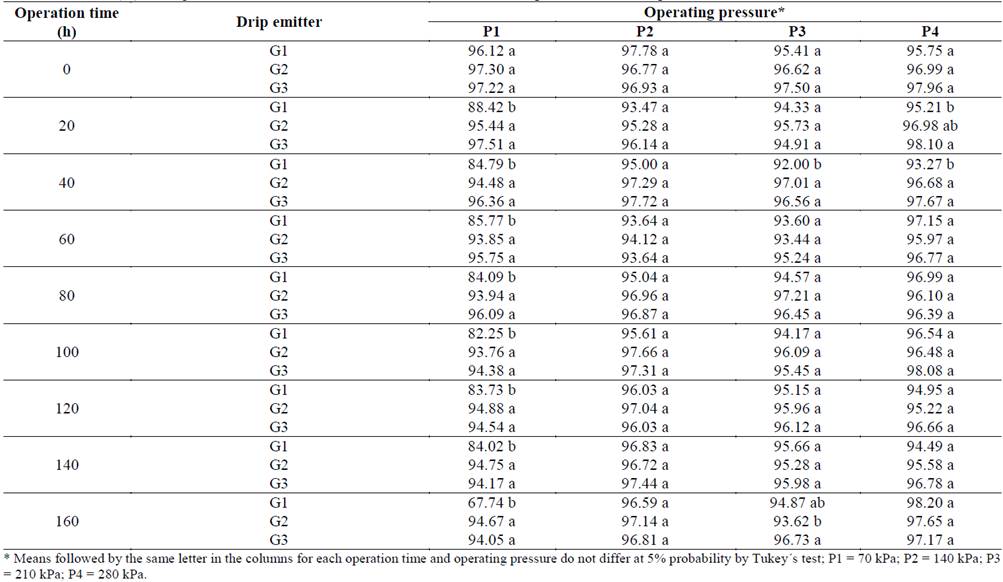
Source: The authors
In operating pressure P1, the CUC of drip irrigation unit with emitter G1 differed from the CUC of irrigation units with emitters G2 and G3 from 20-hour operation time.
In operating pressure P2, there was no significant variation in the CUC of irrigation units with emitters G1, G2 and G3 during the 160h-operation time. The above indicated lower levels of clogging due to the predominance of effluent flow rate in the emitter that impairs particle sedimentation and biofilm formation.
In operating pressure P3, the CUC of drip irrigation unit with G1 differed from CUC of irrigation units with G2 and G3 during the 40-hour operation time. In the 160h-operation time, the CUC of drip irrigation unit with G3 differed from CUC of drip irrigation unit with G2.
In operating pressure P4, the CUC of drip irrigation unit with G1 differed from CUC of drip irrigation unit with G3 in the 20hour-operation time. CUC of irrigation unit with emitter G1 differed from CUC of drip irrigation units with emitters G2 and G3 at 40h-operation time.
It should be underscored that, among the four operating pressures tested, P2 had the best indicators of hydraulic performance. In fact, it is highly recommended for drip irrigation system operating with wastewater generated from the processing of cashew nuts.
Complex biofilm in the three drip emitter models typically develops from the interaction between physical (pH, suspended solids), chemical (dissolved solids, calcium, magnesium and manganese) and biological agents (bacteria). More visible biofilm occurred in the labyrinths of the three drip emitter models. Fig. 3 shows illustrations of drip emitters with biofilm. Biofilm formation was probably due to the lack of opening of end sidelines for cleaning, leading to enhanced clogging effects. Similar process was observed in [7] and [11].














